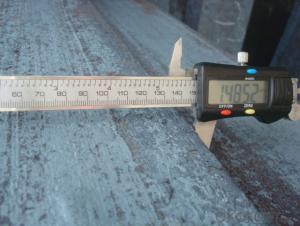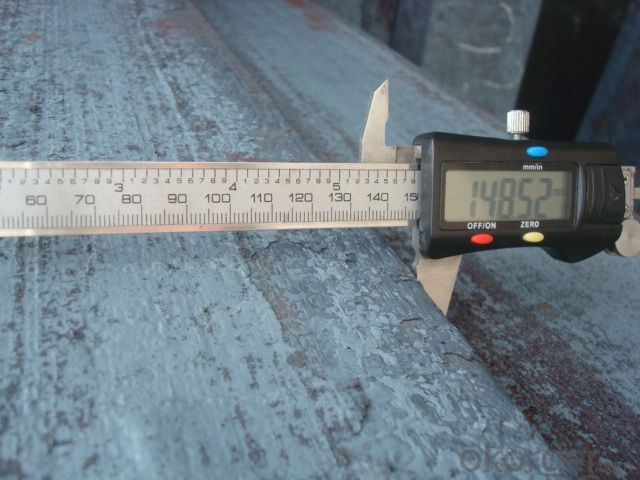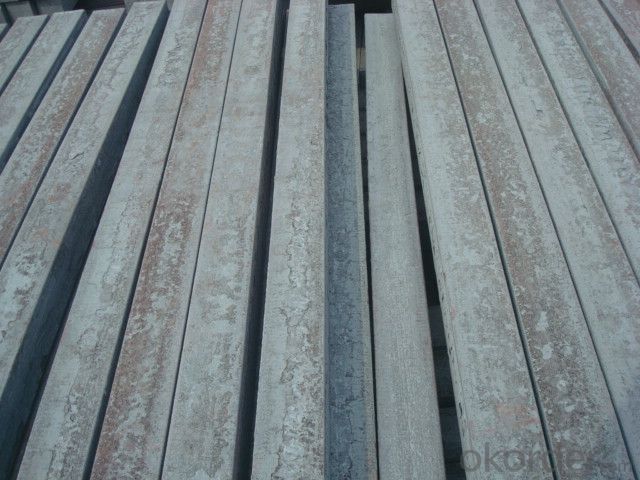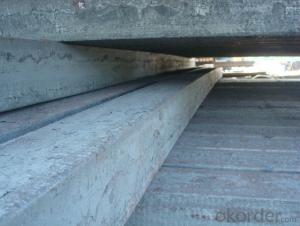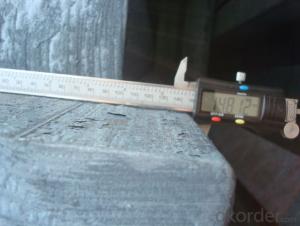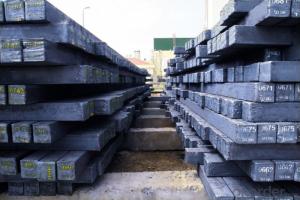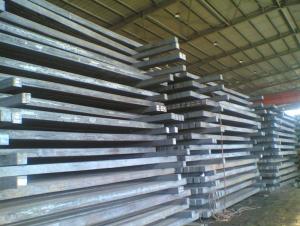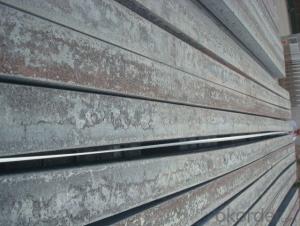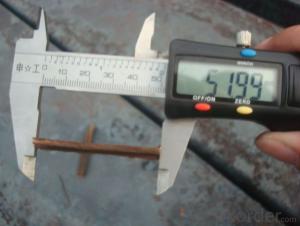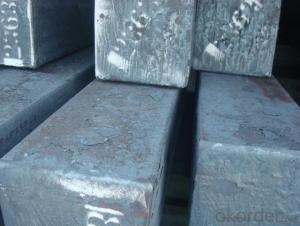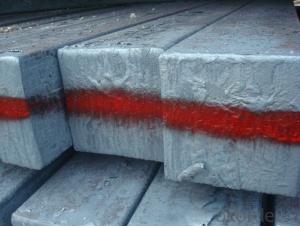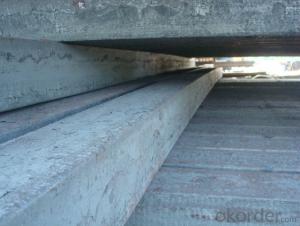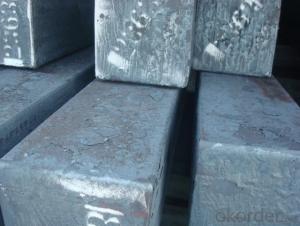Alloyed Continue Casting Steel Billet by Blast Furnace Manufactured by Big Steel Mill
- Loading Port:
- Tianjin
- Payment Terms:
- TT OR LC
- Min Order Qty:
- 1000 m.t.
- Supply Capability:
- 100000 m.t./month
OKorder Service Pledge
OKorder Financial Service
You Might Also Like
Alloyed Continue Casting Steel Billet by Blast Furnace Manufactured by Big Steel Mill
1.Structure of Alloyed Continue Casting Steel Billet by Blast Furnace Manufactured by Big Steel Mill
Alloyed Continue Casting Steel Billet by Blast Furnace According to the Standard of YB2011-83 is the raw material of all kinds of steel mill. Billet section of square, round, flat, rectangular and abnormity, etc Several, mainly related to shape of rolled products. Simple rolled section steel, choose cross section of square billet or rectangular billet. rolling The sector products such as flat steel, Angle steel, select the rectangular billet or slab. Had better profiled billet when production beams, channels, and in rolling process Lines and improve the yield. The raw material of round billet is the production of seamless tube.
2.Main Features of Alloyed Continue Casting Steel Billet by Blast Furnace Manufactured by Big Steel Mill
Steel Bloom Manufactured by Blast Furnace section size should meet the requirements of rolling deformation and finished product quality, but also roll strength and biting condition of restrictions. General steel Billet section height H. And the roll diameter D The ratio of the ( namely H/D) Should be less than or equal to zero 0.5 . Length of steel billet by finishing temperature, Rolling time and the length of the product Or times ruler. When heated too long accident prone to bump the furnace wall of steel, too short, furnace bottom utilization rate is not high, influence the heating furnace production. For the production Choose a variety of steel and steel billet, should consider the affinities of billet, as far as possible in order to improve the productivity of the roughing mill, simplify the stock management of workshop.
3. Alloyed Continue Casting Steel Billet by Blast Furnace Manufactured by Big Steel Mill Images
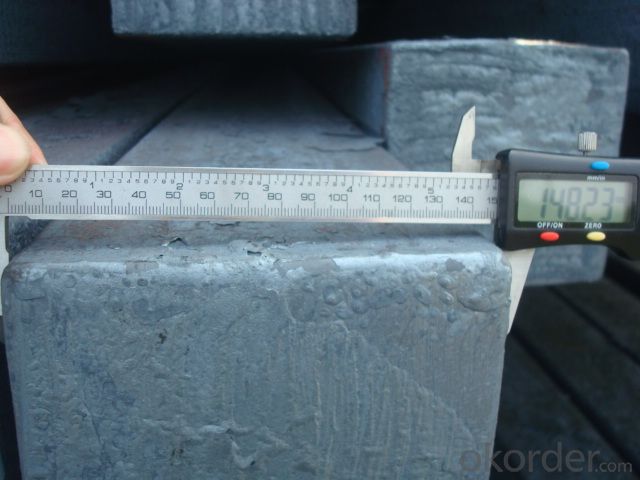
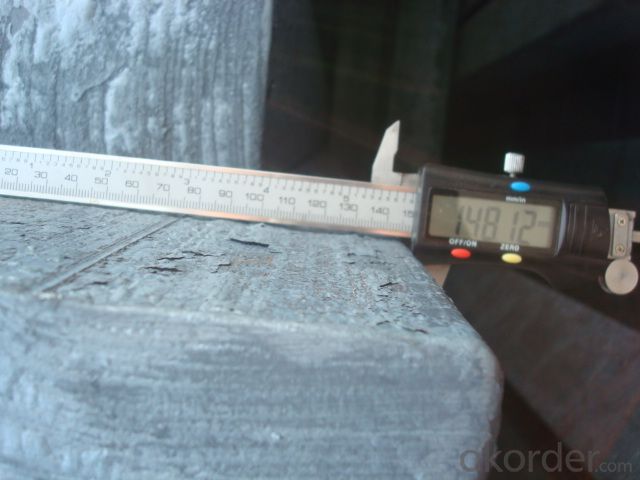
4. Alloyed Continue Casting Steel Billet by Blast Furnace Manufactured by Big Steel Mill Specification
Steel Bloom Manufactured by Blast Furnace rolled steel, after processing can be used for mechanical parts, forging parts, processing all kinds of steel, steel Q345B channel steel, wire rod is the role of the billet. Steel billet is used in the production of semi-finished products, generally cannot be used directly for the society. Steel billets and steel are strictly divided into standard, cannot decide to whether the business enterprise of the final product, and according to unified standards to perform the whole society. Typically, billet and the steel is relatively easy to distinguish, but for some steel billet, and have the same specification and same steel purposes (such as rolling tube billet), whether can be used for other industries, whether through steel processing process, whether through a finished product rolling mill processing to distinguish
Material standard The editor Range of thickness: 150-240 - mm + / - 5 mm width range: 880-1530 - mm + / - 20 mm Length: 3700-10000 - mm + / - 500 - mm Cross-sectional size: 64 * 64; 82 * 82; 98 * 98; 124 * 124; 120 * 150; 152 * 164; 152 * 170 mm Length: 9000 mm Section of tolerance: billet: 1.0 + / - 2.0-1.0 + / - 1.0 mm slab: width: + / - 2.0 mm thickness: + / - 3.0 mm The length tolerance: + / - 200 mm Section diagonal tolerance: 3.5-8.0 MM Billet section size protrusions requirements: < 1242 mm, do not allow; > = 1242 mm, < = 2 mm 1242 mm, < = 3 mm Beheading (shear) extension deformation: < 1242 mm billet: no control; The slab: < = 15 mm Surface tilt: no more than billet section 0.1 Bending: every 1 m length is not more than 10 mm The distortion: length < = 5 m, < = 11. ; The length of the < = 7.5 M, < = 5. Material % 3 sp/PS chemical composition: C Mn Si S P
5.FAQ of Alloyed Continue Casting Steel Billet by Blast Furnace Manufactured by Big Steel Mill
We have organized several common questions for our clients,may help you sincerely:
①How to check every lot of cargo?
Casting billet by batch acceptance, each batch is composed of the same brand, the same cross section size.
②What requirement according to the standard on the size?
Height is greater than the
3 mm
Scratches, indentation, scratch, pores, wrinkles, cold splash, handle, bump, pits
And depth is greater than the
2 mm
The hairline.Casting billet cross-section can not have shrinkage cavity, subcutaneous bubble.
Crack in continuous casting billet surface shall not be visible to the naked eye, overlapping, skull patch, or scarring, inclusion and depth
Height is greater than the
3 mm
Scratches, indentation, scratch, pores, wrinkles, cold splash, handle, bump, pits
And depth is greater than the
2 mm
The hairline.Casting billet cross-section can not have shrinkage cavity, subcutaneous bubble.
③How to check the appearance?
Appearance standard 2.1And the difference between the lengths of the continuous casting billet in cross section of diagonal should conform to the table2The provisions of the. 2.2And the degree of curvature of continuous casting billet per meter shall not be greater than20 mm,The total bending shall not be greater than the total length2%. 2.3, casting billet are allowed drum belly, but height shall not exceed the casting billet length allowed is deviation. 2.4Oblique cutting, casting billet end shall not be greater than20 mm. 2.5Casting billet end caused by shear deformation, spread shall not be greater than the length10%. 2.6, casting billet can not have apparent reverse..
- Q: How is the surface condition of steel billets checked?
- The surface condition of steel billets is typically checked through visual inspection and various non-destructive testing methods. Visual inspection involves thoroughly examining the surface of the billets for any visible defects such as cracks, pits, dents, or scratches. This is usually done by trained inspectors who have a keen eye for detecting surface imperfections. In addition to visual inspection, various non-destructive testing techniques are employed to assess the surface condition of steel billets. These techniques include magnetic particle testing, liquid penetrant testing, ultrasonic testing, and eddy current testing. Magnetic particle testing involves applying a magnetic field to the billet's surface and then applying fine iron particles. If there are any surface defects, such as cracks or inclusions, the magnetic particles will be attracted to these areas and form visible indications. Liquid penetrant testing involves applying a liquid dye to the surface of the billet. The dye penetrates any surface defects, and after a certain period of time, excess dye is removed, and a developer is applied. The developer draws out the dye from any surface defects, making them visible and easy to detect. Ultrasonic testing utilizes high-frequency sound waves to detect surface and subsurface defects. A transducer is used to generate sound waves that penetrate the billet's surface. If there are any defects, such as cracks or voids, the sound waves will reflect back, and by analyzing the reflected waves, any surface or subsurface flaws can be identified. Eddy current testing involves passing an alternating current through a coil placed near the billet's surface. Any surface defects or variations in the material's conductivity will cause changes in the current flow, which can be detected and analyzed to determine the surface condition. These non-destructive testing methods provide accurate and reliable information about the surface condition of steel billets, helping to ensure their quality and integrity before further processing or usage.
- Q: What is the role of steel billets in the manufacturing of construction excavators?
- Steel billets play a crucial role in the manufacturing of construction excavators. These billets, which are essentially semi-finished steel products in the form of a rectangular solid, serve as the primary raw material for constructing various components of excavators. One key aspect of steel billets is their high strength and durability. The construction industry demands materials that can withstand heavy loads, intense pressure, and harsh working conditions. Steel billets possess these characteristics, making them ideal for manufacturing excavators that are capable of withstanding the rigors of construction sites. During the manufacturing process, steel billets are heated and shaped into various components of the excavator. These components include the mainframe, booms, arms, and buckets – all of which require high-strength materials to ensure structural integrity and longevity. Additionally, steel billets allow for precise customization and fabrication. Manufacturers can mold and shape the billets into specific sizes and dimensions required for different parts of the excavator. This flexibility ensures that the components fit together seamlessly, enhancing the overall performance and functionality of the machine. Furthermore, steel billets provide excellent weldability. As excavators undergo constant stress and movements, welding is a crucial process for joining the various components. Steel billets enable strong and reliable welds, ensuring that the excavator remains structurally sound and capable of performing heavy-duty tasks. Overall, the role of steel billets in the manufacturing of construction excavators is indispensable. Their high strength, durability, customizability, and weldability make them the ideal raw material for constructing the robust and reliable machines that are required for the demanding nature of the construction industry.
- Q: What are the potential applications of steel billets in the aerospace industry?
- Steel billets have several potential applications in the aerospace industry. They can be used for the manufacturing of various components such as engine parts, landing gear components, and structural elements. The high strength and durability of steel billets make them suitable for ensuring the structural integrity and safety of aircraft. Additionally, their excellent heat resistance properties make them ideal for applications in the aerospace industry where high temperatures are encountered, such as in jet engines.
- Q: How are steel billets used in the production of machined parts?
- Steel billets are used in the production of machined parts as the starting material. They are heated and shaped into various forms, such as bars, rods, or tubes, which can then be further processed through machining operations like cutting, drilling, or milling. This allows for the creation of precise and complex components used in various industries, including automotive, aerospace, and machinery.
- Q: How are steel billets used in the production of oil and gas components?
- Due to their strength, durability, and ability to withstand extreme conditions, steel billets are indispensable in the production of oil and gas components. These billets serve as essential raw materials in various manufacturing processes for creating the equipment and parts required in the oil and gas industry. One notable application of steel billets in the oil and gas sector is their use in manufacturing pipes and casings. These billets are heated and then rolled or forged into seamless or welded pipes, which are utilized for transporting oil and gas from wells to refineries or distribution centers. The high strength of steel billets ensures that these pipes can endure the high pressure and corrosive nature of the substances being transported. Steel billets are also integral to the production of valves, flanges, and fittings, which are critical components in oil and gas infrastructure. These billets are machined or forged into various shapes and sizes to create these components, used for controlling the flow of oil and gas within pipelines or at different stages of the production process. The durability and resistance to corrosion of steel billets make them ideal for these applications, as they can endure the harsh conditions often encountered in oil and gas operations. Moreover, steel billets find utility in the production of drilling equipment such as drill bits, drill collars, and drill pipes. These billets are frequently treated with heat or alloying elements to enhance their strength and wear resistance. The resulting components can withstand the intense forces and abrasion experienced during drilling operations, ensuring efficient and reliable extraction of oil and gas reserves. In conclusion, steel billets play a crucial role in the oil and gas industry by providing the essential raw materials for manufacturing durable and high-performance components. Their strength, durability, and resistance to corrosion make them an ideal choice for the challenging conditions encountered in the production, transportation, and processing of oil and gas.
- Q: What is the average weight of a steel billet?
- The average weight of a steel billet varies depending on its dimensions and specific grade. However, a typical range for the average weight of a steel billet is between 1,000 and 5,000 pounds.
- Q: What are the different types of machining processes used for shaping steel billets?
- There are several types of machining processes used for shaping steel billets, including turning, milling, drilling, and grinding. Turning involves rotating the billet against a cutting tool to remove excess material and create a desired shape. Milling uses rotary cutters to remove material from the billet, while drilling creates holes using a rotating cutting tool. Grinding involves using an abrasive wheel to remove material and achieve a smooth surface finish. These processes can be performed individually or in combination to achieve the desired shape and dimensions of the steel billet.
- Q: What is the role of steel billets in the production of valves and fittings?
- Valves and fittings, which are crucial in industries like oil and gas, petrochemical, and water treatment, rely heavily on steel billets. These billets, derived from molten steel, serve as the starting point for producing these components. To meet specific requirements, the billets are cast into shapes like round, square, or rectangular. The usage of steel billets enables manufacturers to maintain consistent quality and performance in valves and fittings. The selection process involves considering factors such as chemical composition, mechanical properties, and microstructure to guarantee the desired characteristics in the end product. After obtaining the steel billets, they undergo various manufacturing processes like forging, machining, and heat treatment. These processes further enhance the strength, integrity, and functionality of the final valve and fitting components. One of the advantages of steel billets is their versatility in customization. They can be easily cut, shaped, and formed to create valves and fittings with different sizes, configurations, and designs. This flexibility allows them to meet the specific requirements of different applications and industries. In summary, steel billets serve as the raw material for valves and fittings, playing a vital role in their production. Their strength, durability, and customization capabilities ensure the reliability and performance of these components in various industrial settings.
- Q: What are the different surface defects that can occur in steel billets?
- Some of the different surface defects that can occur in steel billets include cracks, scales, pitting, scratches, and surface irregularities.
- Q: How do steel billets contribute to the overall safety of a structure?
- Steel billets play a significant role in contributing to the overall safety of a structure in several ways. Firstly, steel billets serve as the raw material for manufacturing steel bars, beams, columns, and other structural components. These components are widely used in construction due to their high strength and durability. By using steel billets as the starting material, the resulting steel products exhibit excellent load-bearing capacity, which enhances the structural integrity of the building. Moreover, steel billets undergo a rigorous manufacturing process that includes various quality control checks. These checks ensure that the billets possess consistent and reliable mechanical properties, such as high tensile strength and impact resistance. As a result, when these billets are used in the construction of a structure, they contribute to its overall safety by providing a reliable and robust framework that can withstand external forces, such as wind, earthquakes, or heavy loads. Additionally, steel billets are often produced using advanced metallurgical techniques, such as controlled cooling or heat treatment, to achieve specific properties required for structural applications. These processes help in improving the microstructure of the steel, reducing internal defects, and enhancing its resistance to corrosion, fatigue, and other forms of degradation. This, in turn, increases the lifespan of the structure and minimizes the risk of structural failure, thus ensuring the safety of the occupants. Furthermore, steel billets can be manufactured with precise dimensions and tolerances, allowing for accurate and efficient construction. This precision in fabrication ensures that structural components fit together seamlessly, reducing the likelihood of gaps, misalignments, or weak points that could compromise the safety of the structure. Lastly, steel billets are highly recyclable, making them an environmentally friendly choice for construction. By opting for steel billets, the construction industry can reduce its carbon footprint and contribute to sustainable development. This focus on sustainability aligns with the overall safety of a structure, as a sustainable approach ensures the long-term stability and resilience of the built environment. In conclusion, steel billets contribute to the overall safety of a structure by providing high-strength, durable, and reliable materials for construction. Their consistent mechanical properties, resistance to external forces, improved microstructure, and precise fabrication ensure a strong and secure framework. Moreover, their recyclability promotes sustainability, further enhancing the long-term safety and integrity of the structure.
Send your message to us
Alloyed Continue Casting Steel Billet by Blast Furnace Manufactured by Big Steel Mill
- Loading Port:
- Tianjin
- Payment Terms:
- TT OR LC
- Min Order Qty:
- 1000 m.t.
- Supply Capability:
- 100000 m.t./month
OKorder Service Pledge
OKorder Financial Service
Similar products
Hot products
Hot Searches
Related keywords
